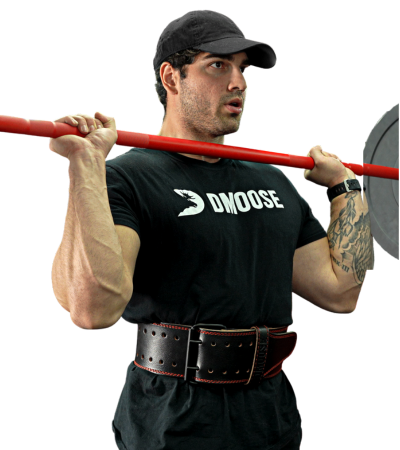Ever wonder why so many lifters at the gym strap on those belts before hitting the weights? A weightlifting belt does more than just make you look serious about your session. This accessory is key to boosting performance and protecting your body, especially when the weights start creeping up.
Let’s explore ‘What does a weightlifting belt do?’ and how it transforms your lifting technique and safety, turning an ordinary workout into an extraordinary one.
What Does a Weightlifting Belt Do?

A weightlifting belt is a staple accessory in gyms and fitness centers, commonly seen around the waist of those lifting heavy weights. But what is a weightlifting belt for? Here's a comprehensive look at what a weightlifting belt does and why incorporating one into your routine can be beneficial.
1. Increases Intra-Abdominal Pressure
Creating a high intra-abdominal pressure (IAP) is crucial when lifting heavy weights. According to research, this pressure is a brace to support and stabilize your spine. A weightlifting belt enhances this effect by giving your abdominal muscles something to push against, increasing the pressure within the abdomen. This additional support can lead to safer and more effective lifts.
2. Improves Body Biomechanics
The belt doesn't just help with safety; it also improves the biomechanics of lifting. Studies have shown that wearing a belt during lifts like squats and deadlifts can reduce the amount of spinal flexion (bending), spinal extension, and lateral flexion (side bending) while increasing the use of the legs and hips. This means that a belt can help you lift more with your legs rather than your back, which is crucial for proper lifting technique and reducing the risk of injury.
3. Enhances Performance
There's also evidence that wearing a weightlifting belt can enhance performance. One study noted that belts could increase muscle power and strength, possibly by improving the body’s biomechanics and efficiency. Lifters often find they can perform more reps at a higher weight when wearing a belt, which can be beneficial for those looking to gain strength or muscle mass.
4. Prevents Injuries
Perhaps one of the most important roles of a weightlifting belt is injury prevention. The belt’s ability to increase intra-abdominal pressure and stabilize the spine is vital for protecting it during heavy lifts. By maintaining better posture and reducing stress on the lower back, a weightlifting belt can help prevent both acute injuries and long-term wear and tear.
5. Psychological Benefits
Wearing a weightlifting belt can also provide psychological benefits. Many lifters feel more confident and secure when they strap on their belt, which can be incredibly important when attempting to lift heavy weights. This increased confidence can lead to improved performance and a greater willingness to push personal limits.
Who Should Get a Weightlifting Belt?

A weightlifting belt is a valuable tool for many athletes, but it's not necessary for everyone. Understanding who should consider using one can help maximize its benefits while ensuring safety and effectiveness. Here are some key groups and situations where a custom weightlifting belt can be particularly useful:
1. Heavy Lifters
Individuals who regularly engage in heavy lifting exercises, such as powerlifters and Olympic weightlifters, are prime candidates for a weightlifting belt. These athletes often lift weights close to their maximum capacity, where additional support can prevent injury and enhance performance.
2. Bodybuilders and Strength Athletes
For bodybuilders and athletes focused on building strength and muscle mass, a leather weightlifting belt can help them perform more reps and handle heavier weights safely. By stabilizing the core and reducing stress on the lower back, the belt allows these athletes to focus on the target muscles more effectively.
3. People with Previous Back Injuries
Individuals who have suffered previous back injuries may find that a weightlifting belt provides the extra support needed to safely engage in strength training. The belt's ability to increase intra-abdominal pressure and stabilize the spine can be crucial for preventing re-injury.
4. CrossFit Athletes
In high-intensity sports like CrossFit, where athletes often perform a variety of lifts and dynamic movements, a weightlifting belt can offer critical support during the heaviest lifts, such as deadlifts, squats, and cleans. The belt helps maintain proper posture and technique under fatigue, which is common in such intense training sessions.
5. Anyone Looking to Improve Lifting Technique
A weightlifting belt can also be a useful tool for those learning proper lifting techniques. It encourages the lifter to maintain a straighter spine and to properly engage their core muscles, which are essential components of safe and effective lifting.
Related Article: How and When to Use a Weightlifting Belt?
When Shouldn’t You Use a Lifting Weight Belt?

There are times when a weightlifting belt isn't necessary or may even be counterproductive.
1. Exercises with Minimal Spinal Erector Engagement
It’s recommended not to use a lifting belt during exercises where the spinal erectors aren't heavily challenged—like during lateral pull-downs or leg extensions—a belt won't improve your performance.
2. Light Weightlifting and Aerobic Activities
Using a belt during light weightlifting or aerobic activities may not benefit you but could potentially increase your blood pressure over time.
This is particularly concerning for individuals with heart or blood pressure conditions, who should be cautious about wearing a belt tightly or for extended periods.
3. Impact on Abdominal Muscle Strength
Consistently relying on a belt can also impede the strength development of your abdominal muscles. Studies using electromyography have shown reduced activity in the abdominal muscles when belts are used during lifting.
This reduction can lead to weaker abdominals since the natural stabilizing forces of these muscles are less engaged.
4. Trunk Stability and Natural Muscle Engagement
Developing strong abdominal muscles is crucial for maintaining trunk stability without relying on external support like a belt. Becoming too dependent on a belt can be problematic, especially in competitions where belts may not be allowed.
It's also important to master proper bracing and breathing techniques to make the most out of using a weightlifting belt. Techniques such as the Valsalva maneuver can help create necessary abdominal pressure to support and protect the spine effectively.
What Weightlifting Belt Should You Get?

The DMoose 5mm Powerlifting Belt is an excellent leather weightlifting belt for men and women to enhance their lifting performance. Here's a detailed look at its features:
- Durable Support: Constructed from premium leather with a thickness of 5mm, this belt provides solid support essential for handling heavy loads, reducing the risk of injury during high-intensity lifting sessions.
- Secure Fit: It features a robust, double-pronged coated buckle that ensures the belt remains securely fastened around your waist. This stability is critical during explosive lifts and complex movements.
- Enhanced Lifting Efficiency: By increasing intra-abdominal pressure, the belt supports your core and stabilizes your spine, which can help you lift more weight safely. This not only improves your strength but also enhances your overall lifting technique.
- Versatile Use: While it's tailored for powerlifting, its quality and design make it suitable for a broad range of strength training activities, ensuring it’s a versatile addition to your gym gear.
- Multiple Sizes Available: The product comes in different sizes. You can get your perfect fit from the 5mm weightlifting belt size chart by comparing your waist size with the values provided in the chart.
- Bonus Features: The inclusion of a carry bag is a thoughtful touch, providing a convenient way to store and transport the belt, protecting it from wear and tear.
- Reliability and Support: DMoose stands behind its product with a lifetime warranty, reflecting its confidence in the belt’s quality and its commitment to customer satisfaction.
Given these features, the DMoose 5mm Powerlifting Belt is highly recommended for lifters at all levels who seek a reliable, high-quality belt to support their fitness goals.
Choosing the Right Type of Weightlifting Belt
|
Belt Type |
Image |
Ideal for |
Exercises |
Shop from DMoose |
Shop from Amazon |
|
Prong Belts |
|
|
|||
|
Lever Belts |
|
|
|||
|
Velcro Belts |
|
|
When choosing a weightlifting belt, prong belts are ideal for serious weightlifters and powerlifters due to their robust design and secure fit, perfect for heavy lifts like squats and deadlifts.
Lever belts also cater to weightlifters and powerlifters, offering the added convenience of quick adjustments with a lever mechanism, making them suitable for similar heavy exercises.
Velcro belts, however, are more versatile, fitting fitness enthusiasts, weightlifters, and CrossFit athletes. They provide quick adjustments and are suitable for a wide range of exercises, including functional fitness routines and high-intensity workouts.
Final Thoughts
A lifting weight belt is essential for anyone engaging in heavy lifting, as it increases intra-abdominal pressure, improves biomechanics, enhances performance, and prevents injuries. It's particularly beneficial for powerlifters, bodybuilders, those with past back injuries, CrossFit athletes, and anyone aiming to improve lifting techniques. However, it's not necessary for exercises that don't heavily involve the spinal erectors or during light workouts.
For high-quality, durable lifting support, consider the DMoose 5mm Powerlifting Belt. It is among the best weightlifting belts designed to enhance lifting efficiency and ensure safety. Explore more about this product and other reliable weightlifting gear at DMoose.
Reading List
Can Wearing a Belt for Overhead Press Increase Performance?
Traveling With Your Lifting Belt: A Guide to Stay Fit On-The-Go
15 Best Weightlifting Belts for Powerlifters
7 Simple Tips to Choose the Right Weightlifting Belt | Do Not Get Scammed
Can Wearing a Belt for Overhead Press Increase Performance?
Master the Fit With a Quick Guide to Measuring a Weightlifting Belt
References
- Bourne ND, Reilly T. (1991). Effect of a weightlifting belt on spinal shrinkage. British Journal of Sports Medicine, 25(4), pp. 209-12. PubMed Central. Available from: https://www.ncbi.nlm.nih.gov/pmc/articles/PMC1479027/.
- Fong SSM, et al. (2022). The influence of weightlifting belts and wrist straps on deadlift kinematics, time to complete a deadlift and rating of perceived exertion in male recreational weightlifters. Medicine, 101(7), p. e28918. PubMed Central. DOI: https://doi.org/10.1097/MD.0000000000028918.
- Nakai Y, et al. (2023). Effects of external abdominal pressure support on dynamic balance: a randomized crossover study. Sports (Basel, Switzerland), 11(11), p. 217. PubMed. DOI: https://doi.org/10.3390/sports11110217.



















